Spatio-Temporal Variation and Influencing Factors of the Coupling Coordination Degree of Production-Living-Ecological Space in China
Abstract
:1. Introduction
2. Literature Review
2.1. PLES
2.2. Driving Forces of Coupling Coordination Degree of PLES
3. Materials and Methods
3.1. Data Sources
3.2. Methods
3.2.1. Definition and Calculation of PLES Index
3.2.2. Gravity Centers of PLES Index
3.2.3. Coupling Coordination Analysis of PLES Index
3.2.4. Spatial Autocorrelation
3.2.5. Model Construction and Selection of Influencing Factors
4. Results
4.1. Spatio-Temporal Distribution of PLES Index in China from 2000 to 2020
4.2. Gravity Centers of PLES Index in China from 2000 to 2020
4.3. Coupling Coordination Degree of PLES Index in China from 2000 to 2020
4.3.1. Coupling Coordination Degree of Subsystems of PLES Index in China from 2000 to 2020
4.3.2. Coupling Coordination Degree of PLES Index in China from 2000 to 2020
4.4. Spatial Autocorrelation Analysis of Coupling Coordination Degree of PLES in China from 2000 to 2020
4.5. Spatial Heterogeneity Analysis of Influencing Factors of Coupling Coordination Degree of PLES in China from 2000 to 2020
5. Discussion
5.1. Interpretation of Results
5.1.1. Spatio-Temporal Distribution of PLES Index in China from 2000 to 2020
5.1.2. Gravity Centers of PLES Index in China from 2000 to 2020
5.1.3. Coupling Coordination Degree of PLES Index in China from 2000 to 2020
5.1.4. Spatial Autocorrelation Analysis of Coupling Coordination Degree of PLES in China from 2000 to 2020
5.1.5. Spatial Heterogeneity Analysis of Influencing Factors of Coupling Coordination Degree of PLES in China from 2000 to 2020
5.2. Policy Implications
5.3. Limitation and Future Direction
6. Conclusions
Supplementary Materials
Author Contributions
Funding
Institutional Review Board Statement
Informed Consent Statement
Data Availability Statement
Conflicts of Interest
References
- Song, Y.Y.; Xue, D.Q.; Xia, S.Y.; Mi, W.B. Change characteristics and formation mechanism of the territorial spatial pattern in the Yellow River Basin from 1980 to 2018, China. Geogr. Res. 2021, 40, 1445–1463. [Google Scholar]
- Li, J.S.; Sun, W.; Li, M.Y.; Meng, L.L. Coupling coordination degree of production, living and ecological spaces and its influencing factors in the Yellow River Basin. J. Clean. Prod. 2021, 298, 126803. [Google Scholar] [CrossRef]
- Duan, Y.M.; Wang, H.; Huang, A.; Xu, Y.Q.; Lu, L.H.; Ji, Z.X. Identification and spatial-temporal evolution of rural “production-living-ecological” space from the perspective of villagers‘ behavior—A case study of Ertai Town, Zhangjiakou City. Land Use Policy 2021, 106, 105457. [Google Scholar] [CrossRef]
- Cheng, Z.L.; Zhang, Y.L.; Wang, L.Z.; Wei, L.Y.; Wu, X.Y. An analysis of land-use conflict potential based on the perspective of production–living–ecological function. Sustainability 2022, 14, 5936. [Google Scholar] [CrossRef]
- Wang, Q.; Wang, H.J. Dynamic simulation and conflict identification analysis of production–living–ecological space in Wuhan, Central China. Integr. Environ. Asses. 2022, 1–19. [Google Scholar] [CrossRef]
- Wang, A.Y.; Liao, X.Y.; Tong, Z.J.; Du, W.L.; Zhang, J.Q.; Liu, X.P.; Liu, M.S. Spatial-temporal dynamic evaluation of the ecosystem service vValue from the perspective of “production-living-ecological” spaces: A case study in Dongliao River Basin, China. J. Clean. Prod. 2022, 333, 130218. [Google Scholar] [CrossRef]
- Huang, J.C.; Lin, H.X.; Qi, X.X. A literature review on optimization of spatial development pattern based on ecological-production-living space. Prog. Geog. 2017, 36, 378–391. [Google Scholar]
- Wang, D.; Fu, J.Y.; Jiang, D. Optimization of production–living–ecological space in national key poverty-stricken city of Southwest China. Land 2022, 11, 411. [Google Scholar] [CrossRef]
- Fu, X.X.; Wang, X.F.; Zhou, J.T.; Ma, J.H. Optimizing the production-living-ecological Space for reducing the ecosystem services deficit. Land 2021, 10, 1001. [Google Scholar] [CrossRef]
- Zhang, X.S.; Xu, Z.J. Functional coupling degree and human activity intensity of production–living–ecological space in underdeveloped regions in China: Case study of Guizhou Province. Land 2021, 10, 56. [Google Scholar] [CrossRef]
- Yang, Y.Y.; Bao, W.K.; Liu, Y.S. Coupling coordination analysis of rural production-living-ecological space in the Beijing-Tianjin-Hebei Region. Ecol. Indic. 2020, 117, 106512. [Google Scholar] [CrossRef]
- Wang, D.; Jiang, D.; Fu, J.Y.; Lin, G.; Zhang, J.L. Comprehensive assessment of production–living–ecological space based on the coupling coordination degree model. Sustainability 2020, 12, 2009. [Google Scholar] [CrossRef] [Green Version]
- Liao, L.H.; Dai, W.Y.; Chen, J.; Huang, W.L.; Jiang, F.Q.; Hu, Q.F. Spatial conflict between ecological-production-living spaces on Pingtan Island during rapid urbanization. Resour. Sci. 2017, 39, 1823–1833. [Google Scholar]
- Jiao, L.; Xue, Z.J.; Yin, J.; Zhu, S.L. Eco-environmental effects of land use transition in karst area based on the view of “ecological-production-living spaces”: Taking Guizhou Province as an example. Ecol. Econ. 2020, 36, 206–212. [Google Scholar]
- Bai, R.; Shi, Y.; Pan, Y. Land-use classifying and identification of the production-living-ecological space of island villages—A case study of islands in the western sea area of Guangdong province. Land 2022, 11, 705. [Google Scholar] [CrossRef]
- Liao, G.T.; He, P.; Gao, X.S.; Lin, Z.Y.; Huang, C.Y.; Zhou, W.; Deng, O.P.; Xu, C.H.; Deng, L.J. Land use optimization of rural production–living–ecological space at different scales based on the BP–ANN and CLUE–S Models. Ecol. Indic. 2022, 137, 108710. [Google Scholar] [CrossRef]
- Deng, Y.X.; Yang, R. Influence mechanism of production-living-ecological space changes in the urbanization process of Guangdong province, China. Land 2021, 10, 1357. [Google Scholar] [CrossRef]
- Tao, Y.Y.; Wang, Q.X. Quantitative recognition and characteristic analysis of production-living-ecological space evolution for five resource-based cities: Zululand, Xuzhou, Lota, Surf Coast and Ruhr. Remote Sens. 2021, 13, 1563. [Google Scholar] [CrossRef]
- Xie, X.T.; Li, X.S.; Fan, H.P.; He, W.K. Spatial analysis of production-living-ecological functions and zoning method under symbiosis theory of Henan, China. Environ. Sci. Pollut. Res. 2021, 28, 69093–69110. [Google Scholar] [CrossRef]
- Zhao, Y.Q.; Cheng, J.H.; Zhu, Y.G.; Zhao, Y.P. Spatiotemporal evolution and regional differences in the production-living-ecological space of the urban agglomeration in the Middle Reaches of the Yangtze River. Int. J. Env. Res. Pub. He. 2021, 18, 12497. [Google Scholar] [CrossRef]
- Wei, L.Y.; Zhang, Y.J.; Wang, L.Z.; Mi, X.Y.; Wu, X.Y.; Cheng, Z.L. Spatiotemporal evolution patterns of “production-living-ecological” spaces and the coordination level and optimization of the functions in Jilin Province. Sustainability 2021, 13, 13192. [Google Scholar] [CrossRef]
- Yu, R.; Qin, Y.; Xu, Y.T.; Chuai, X.W. Study on the optimization of territory spatial “urban–agricultural–ecological” pattern based on the improvement of “production–living–ecological” function under carbon constraint. Int. J. Env. Res. Pub. He. 2022, 19, 6149. [Google Scholar] [CrossRef] [PubMed]
- Chen, H.J.; Yang, Q.Y.; Su, K.C.; Zhang, H.Z.; Lu, D.; Xiang, H.; Zhou, L.L. Identification and optimization of production-living-ecological space in an ecological foundation area in the upper reaches of the Yangtze river: A case study of Jiangjin district of Chongqing, China. Land 2021, 10, 863. [Google Scholar] [CrossRef]
- Li, C.X.; Wu, J.Y. Land use transformation and eco-environmental effects based on production-living-ecological spatial synergy: Evidence from Shaanxi province, China. Environ. Sci. Pollut. Res. 2022, 29, 41492–41504. [Google Scholar] [CrossRef]
- Jiang, X.T.; Zhai, S.Y.; Liu, H.; Chen, J.; Zhu, Y.Y.; Wang, Z. Multi-scenario simulation of production-living-ecological space and ecological effects based on shared socioeconomic pathways in Zhengzhou, China. Ecol. Indic. 2022, 137, 108750. [Google Scholar] [CrossRef]
- Kong, L.Y.; Xu, X.D.; Wang, W.; Wu, J.X.; Zhang, M.Y. Comprehensive evaluation and quantitative research on the living protection of traditional villages from the perspective of “production–living–ecology”. Land 2021, 10, 570. [Google Scholar] [CrossRef]
- Zhang, H.Q.; Xu, E.Q.; Zhu, H.Y. An ecological-living-industrial land classification system and its spatial distribution in China. Resour. Sci. 2015, 37, 1332–1338. [Google Scholar]
- Li, G.D.; Fang, C.L. Quantitative function identification and analysis of urban ecological-production-living spaces. Acta Geogr. Sin. 2016, 71, 49–65. [Google Scholar]
- Liu, J.L.; Liu, Y.S.; Li, Y.R. Classification evaluation and spatial-temporal analysis of ”production-living-ecological” spaces in China. Acta Geogr. Sin. 2017, 70, 1290–1304. [Google Scholar]
- Xi, F.R.; Wang, R.P.; Shi, J.S.; Zhang, J.D.; Yu, Y.; Wang, N.; Wang, Z.Y. Spatio-temporal pattern and conflict identification of production–living–ecological space in the Yellow River Basin. Land 2022, 11, 744. [Google Scholar] [CrossRef]
- Pang, R.Q.; Hu, N.; Zhou, J.R.; Sun, D.Q.; Ye, H.Y. Study on eco-environmental effects of land-use transitions and their influencing factors in the Central and Southern Liaoning Urban Agglomeration: A Production–Living–Ecological Perspective. Land 2022, 11, 937. [Google Scholar] [CrossRef]
- Yuan, S.F.; Tang, Y.Y.; Shentu, C.N. Spatiotemporal change of land-use transformation and its eco-environmental response: A case of 127 counties in Yangtze River Economic Belt. Econ. Geogr. 2019, 39, 174–181. [Google Scholar]
- Shi, Z.Q.; Deng, W.; Zhang, S.Y. Spatial pattern and spatio-temporal change of territory space in Hengduan mountains region in recent 25 Years. Geogr. Res. 2018, 37, 607–621. [Google Scholar]
- Liu, Y.; Geng, W.L.; Shao, J.W.; Zhou, Z.M.; Zhang, P.Y. Land use change and ecosystem service value response from the perspective of “ecological-prodection-living spaces”: A case study of lower Yellow River. Areal Res. Dev. 2021, 40, 129–135. [Google Scholar]
- Kong, D.Y.; Chen, H.G.; Wu, K.S. The evolution of “production-living-production” space eco-environmental effects and its influencing factors in China. J. Nat. Resour. 2021, 36, 1116–1135. [Google Scholar] [CrossRef]
- Kuang, W.; Zhang, S.; Du, G.; Yan, C.; Wu, S.; Li, R.; Lu, D.; Pan, T.; Ning, J.; Guo, C.; et al. Remotely sensed mapping and analysis of spatio-temporal patterns of land use change across China in 2015–2020. Acta Geogr. Sin. 2022, 71, 1056–1071. [Google Scholar]
- Liu, J.Y.; Kuang, W.H.; Zhang, Z.X. Spatiotemporal characteristics, patterns, and causes of land-use changes in china since the late 1980S. J. Geogr. Sci. 2014, 24, 195–210. [Google Scholar] [CrossRef]
- Dai, W.Y.; Jiang, F.Q.; Huang, W.L.; Liao, L.H.; Jiang, K. Study on transition of land use function and ecosystem service value based on the conception of production, living and ecological space: A case study of the Fuzhou New Area. Resour. Sci. 2018, 33, 2098–2109. [Google Scholar]
- Cui, J.X.; Gu, J.; Sun, J.W.; Luo, J. The spatial pattern and evolution characteristics of the production, living and ecological space in Hubei Provence. China Land Sci. 2018, 32, 67–73. [Google Scholar]
- Ling, Z.Y.; Li, Y.S.; Jiang, W.G.; Liao, C.M.; Ling, Y.R. Dynamic change characteristics of “production-living-ecological spaces” of urban agglomeration interlaced with mountains, rivers and sea: A case study of the Beibu Gulf Urban Agglomeration in Guangxi. Econ. Geogr. 2022, 42, 18–24. [Google Scholar]
- Feng, T.; Shi, P.J.; Zhang, X.B.; Liu, C.F.; Zhang, W.P. Competition and eco-environmental effect of ecological-production-living spaces in valley city—A case study of Lanzhou City. Res. Soil Water Conserv. 2021, 28, 229–234. [Google Scholar]
- Chen, W.X.; Ye, X.Y.; Li, J.F.; Fan, X.; Liu, Q.S.; Dong, W.C. Analyzing requisition–compensation balance of farmland policy in China through telecoupling: A case study in the Middle Reaches of Yangtze River Urban Agglomerations. Land Use Policy 2019, 83, 134–146. [Google Scholar] [CrossRef]
- Chen, W.X.; Chi, G.Q. Spatial mismatch of ecosystem service demands and supplies in China, 2000–2020. Environ. Monit. Assess. 2022, 194, 295. [Google Scholar] [CrossRef] [PubMed]
- Wang, C.; Tang, N. Spatio-temporal characteristics and evolution of rural production-living-ecological space function coupling coordination in Chongqing Municipality. Geogr. Res. 2018, 37, 1100–1114. [Google Scholar]
- Chen, W.X.; Chi, G.Q.; Li, J.F. The spatial association of ecosystem services with land use and land cover change at the county level in China, 1995–2015. Sci. Total Environ. 2019, 669, 459–470. [Google Scholar] [CrossRef] [PubMed]
- Chen, W.X.; Zeng, Y.Y.; Zeng, J. Impacts of traffic accessibility on ecosystem services: An integrated spatial approach. J. Geogr. Sci. 2021, 31, 1816–1836. [Google Scholar] [CrossRef]
- Fotheringham, A.S.; Brunsdon, C.; Charlton, M. Geographically Weighted Regression: The Analysis of Spatially Varying Relationships; Wiley: Chichester, UK, 2002. [Google Scholar]
- Chen, W.X.; Zeng, J.; Li, N. Change in land-use structure due to urbanisation in China. J. Clean. Prod. 2021, 321, 128986. [Google Scholar] [CrossRef]
- Wei, L.; Luo, Y.; Wang, M.; Su, S.L.; Pi, J.H.; Li, G. Essential fragmentation metrics for agricultural policies: Linking landscape pattern, ecosystem service and land use management in urbanizing China. Agric. Syst. 2020, 182, 102833. [Google Scholar] [CrossRef]
- Zhuang, D.F.; Liu, J.Y. Study on the model of regional differentiation of land use degree in China. J. Nat. Resour. 1997, 12, 10–12. [Google Scholar]
- Liu, P.F.; Sun, B.D. The spatial pattern of urban production-living-ecological space quality and its related factors in China. Geogr. Res. 2020, 39, 13–24. [Google Scholar]
- Lin, J.H.; Li, L. The history, achievement and future path of green development in the 20 years of the development of western China. J. Shaanxi Norm. Univ. (Philos. Soc. Sci. Ed.) 2019, 48, 76–88. [Google Scholar]
- Fu, J.C.; Zhang, S.L. Functional assessment and coordination characteristics of production, living, ecological function—A case study of Henan Province, China. Int. J. Environ. Res. Public Health 2021, 18, 8051. [Google Scholar] [CrossRef] [PubMed]
- Lin, G.; Jiang, D.; Fu, J.Y.; Zhao, Y. A review on the overall optimization of production–living–ecological space: Theoretical basis and conceptual framework. Land 2022, 11, 345. [Google Scholar] [CrossRef]
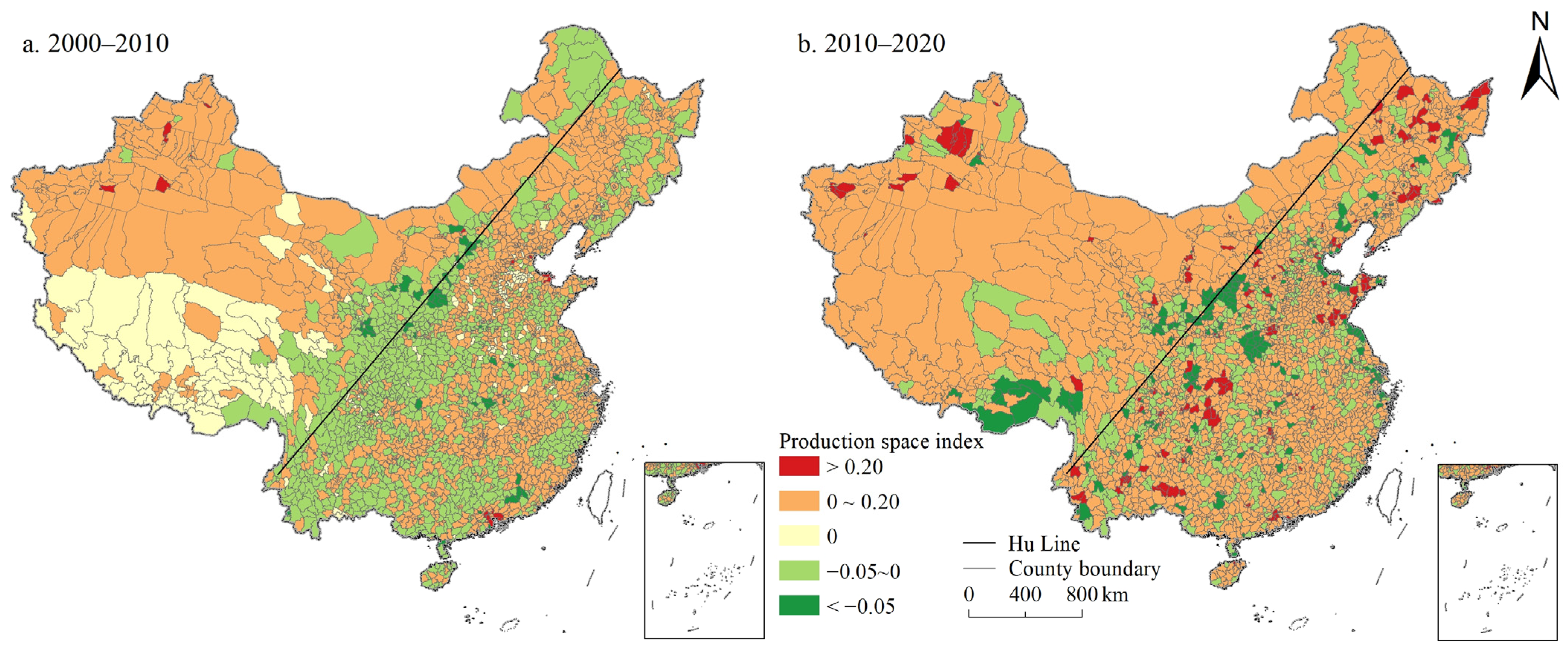

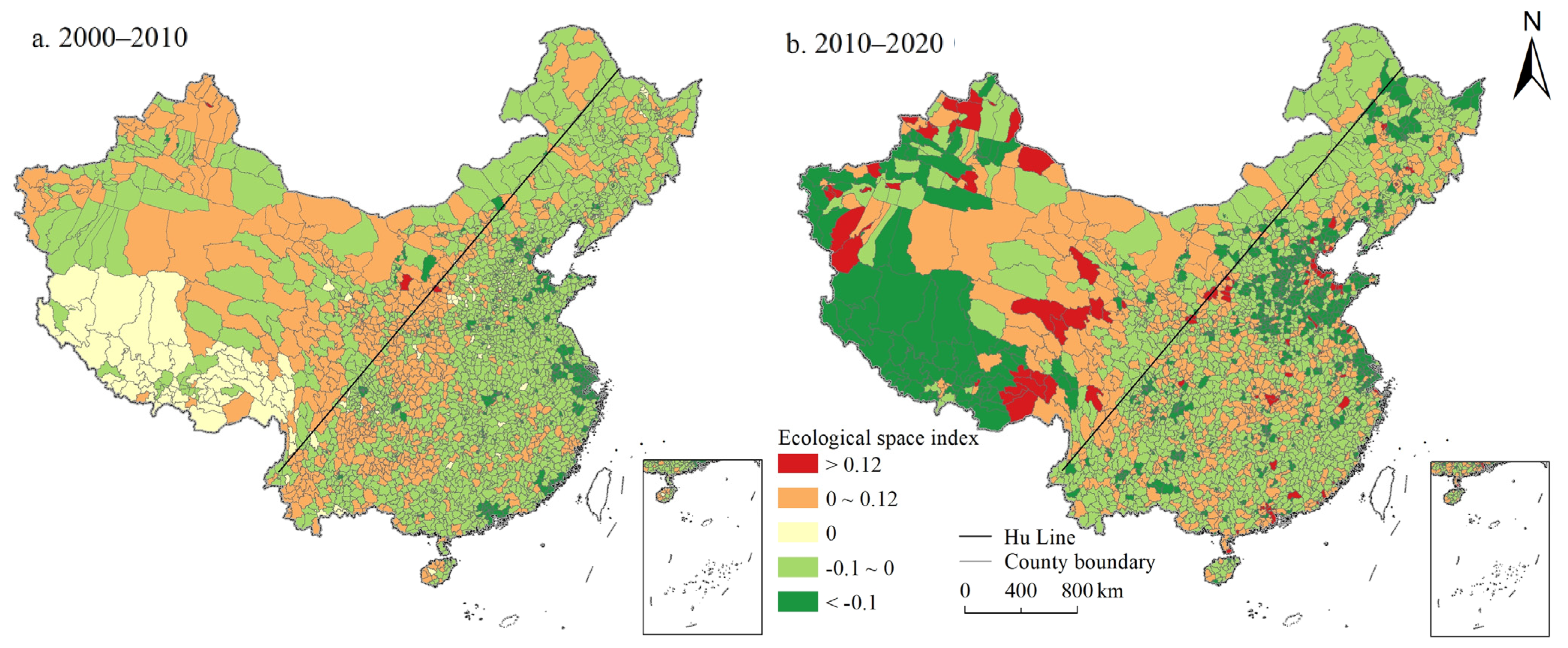
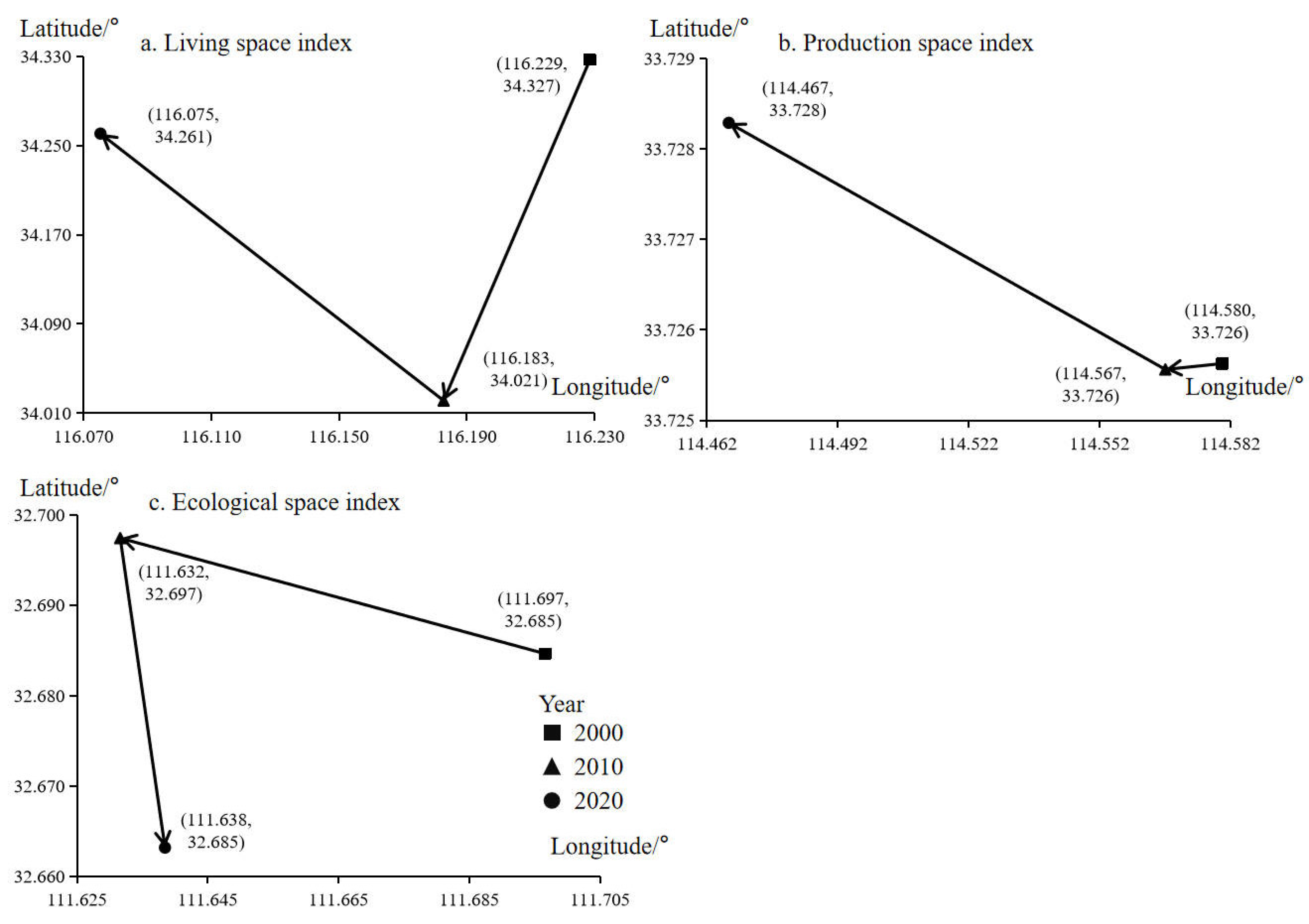





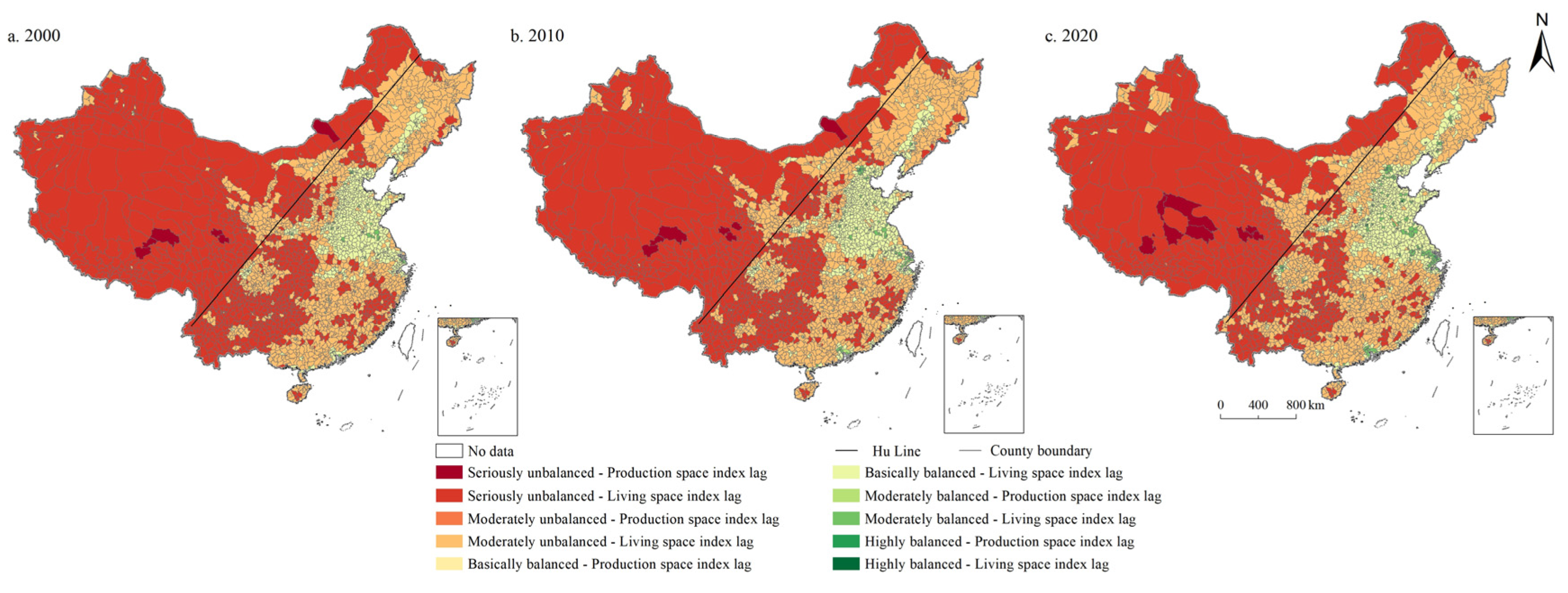

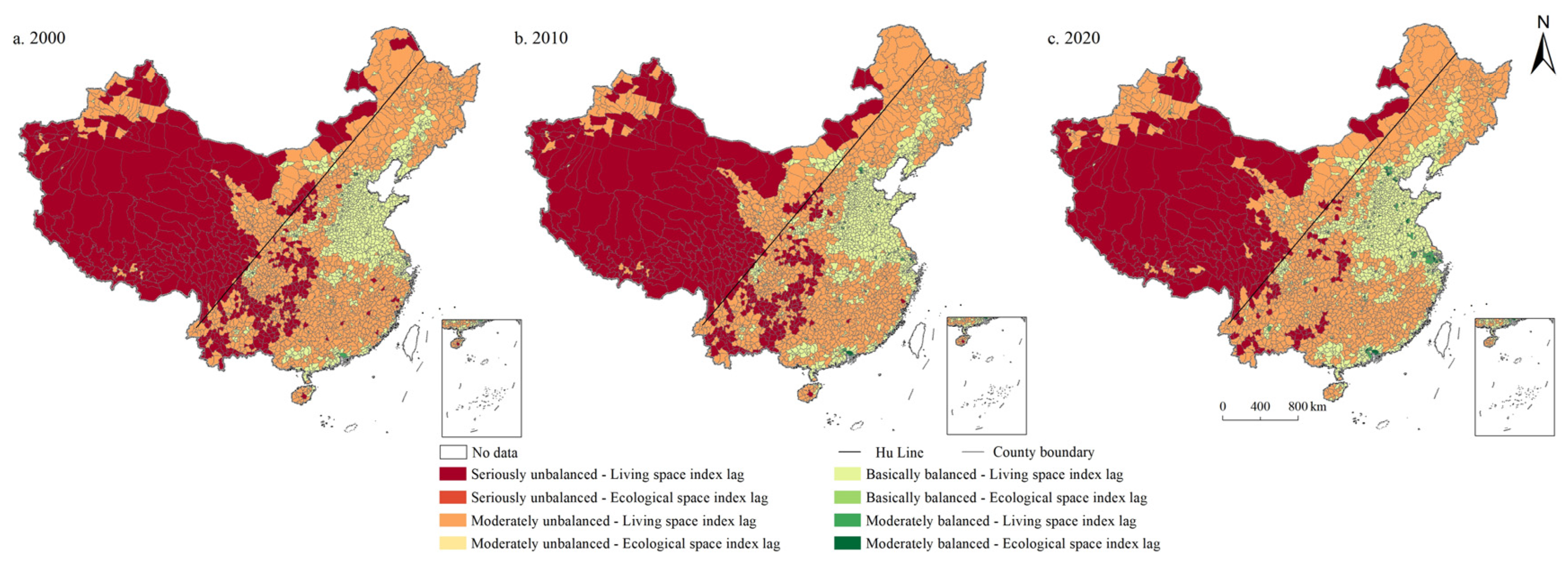

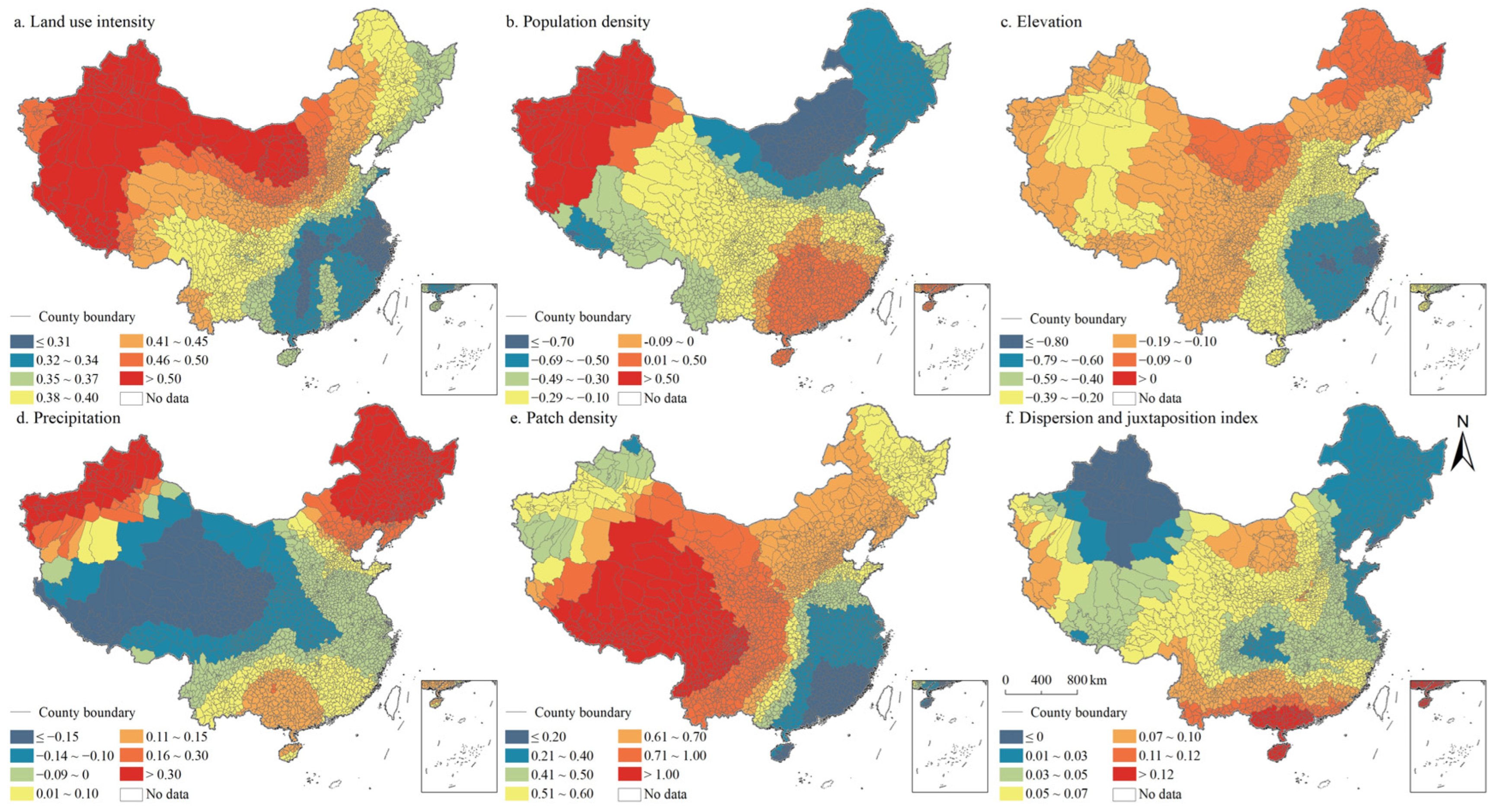

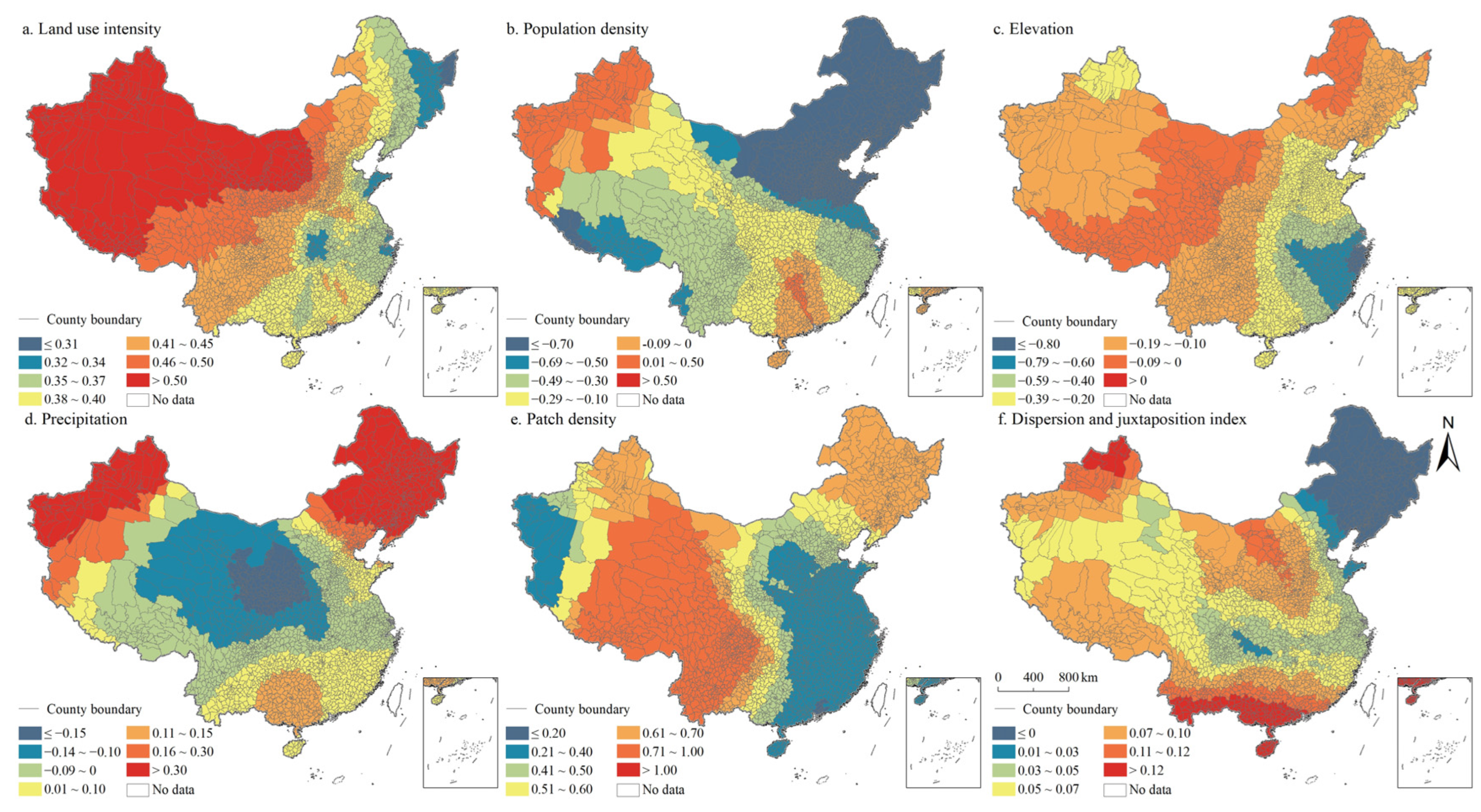
| First-Level Land Use Types | Code | Second-Level Land Use Types | Production Land | Living Land | Ecological Land | First-Level Land Use Types | Code | Second-Level Land Use Types | Production Land | Living Land | Ecological Land |
|---|---|---|---|---|---|---|---|---|---|---|---|
| Cultivated land | 11 | Paddy field | 3 | 0 | 3 | Construction land | 52 | Rural settlements | 3 | 5 | 0 |
| 12 | Dry land | 3 | 0 | 3 | 53 | Other construction land | 5 | 1 | 0 | ||
| Forestland | 21 | Forest | 1 | 0 | 5 | Unused land | 61 | Sandy land | 0 | 0 | 1 |
| 22 | Shrub | 0 | 0 | 5 | 62 | Gobi | 0 | 0 | 1 | ||
| 23 | Woods | 0 | 0 | 5 | 63 | Salina | 0 | 0 | 1 | ||
| 24 | Others | 0 | 0 | 5 | 65 | Bare soil | 0 | 0 | 1 | ||
| Grassland | 31 | Dense grassland | 0 | 0 | 5 | 66 | Bare rock | 0 | 0 | 1 | |
| 32 | Moderate grassland | 0 | 0 | 5 | 67 | Others | 0 | 0 | 1 | ||
| 33 | Sparse grassland | 0 | 0 | 3 | Wetland | 44 | Permanent ice andsnow | 0 | 0 | 5 | |
| Water area | 41 | Stream and rivers | 0 | 0 | 5 | 45 | Beach and shore | 0 | 0 | 5 | |
| 42 | Lakes | 0 | 0 | 5 | 46 | Bottomland | 0 | 0 | 5 | ||
| 43 | Reservoir and ponds | 1 | 0 | 1 | 64 | Swampland | 0 | 0 | 5 | ||
| 51 | Urban built-up | 3 | 5 | 0 |
| Category | Coupling Coordination Degree | Sub-Category | Relative Relation |
|---|---|---|---|
| Seriously unbalanced | 0 ≤ D ≤ 0.2 | Seriously unbalanced PSI lag | N = PSI |
| Seriously unbalanced LSI lag | N = LSI | ||
| Seriously unbalanced ESI lag | N = ESI | ||
| Moderately unbalanced | 0.2 ≤ D ≤ 0.4 | Moderately unbalanced PSI lag | N = PSI |
| Moderately unbalanced LSI lag | N = LSI | ||
| Moderately unbalanced ESI lag | N = ESI | ||
| Basically balanced | 0.4 ≤ D ≤ 0.6 | Basically balanced PSI lag | N = PSI |
| Basically balanced LSI lag | N = LSI | ||
| Basically balanced ESI lag | N = ESI | ||
| Moderately balanced | 0.6 ≤ D ≤ 0.8 | Moderately balanced PSI lag | N = PSI |
| Moderately balanced LSI lag | N = LSI | ||
| Moderately balanced ESI lag | N = ESI | ||
| Highly balanced | 0.8 ≤ D ≤ 1 | Highly balanced PSI lag | N = PSI |
| Highly balanced LSI lag | N = LSI | ||
| Highly balanced ESI lag | N = ESI |
| Dimensions | Metrics | Calculation Method |
|---|---|---|
| Natural environment | DEM | DEM treated by depression filling was extracted in ArcGIS 10.3 using the Zonal Statistic tool. |
| Precipitation | It was extracted by Arc Toolbox/Spatial Analyst Tools/Zonal/Zonal Statistics tool in ArcGIS 10.3. | |
| Social economy | Land use intensity | Referring to the measurement model of land use degree proposed by Zhuang et al. (1997), the natural balance retention state of China’s land system under the effect of social factors was measured [50]. |
| Population density | It was extracted by Arc Toolbox/Spatial Analyst Tools/Zonal/Zonal Statistics tool in ArcGIS 10.3. | |
| Landscape pattern | Patch density | where PD is the patch density. m is the total number of landscape types. LA is the total landscape area of the study area. Ni is the number of patches of land use type i. |
| Interspersion and juxtaposition index | where IJI is the interspersion and juxtaposition index; eik is the total edge length between the patch types i and k in the landscape. m is the number of patch types. |
| Variable | 2000 | 2010 | 2020 | ||||||||||||
|---|---|---|---|---|---|---|---|---|---|---|---|---|---|---|---|
| Coefficient | StdError | t-Statistic | Probability | VIF | Coefficient | StdError | t-Statistic | Probability | VIF | Coefficient | StdError | t-Statistic | Probability | VIF | |
| Intercept | 0.354 | 0.008 | 25.481 | 0.000 | 0.538 | 0.011 | 49.512 | 0.000 | 0.193 | 0.008 | 23.325 | 0.000 | |||
| Land use intensity | 0.411 | 0.010 | 43.179 | 0.000 | 2.291 | 0.371 | 0.013 | 28.941 | 0.000 | 2.329 | 0.445 | 0.009 | 46.931 | 0.000 | 2.407 |
| Population density | −0.277 | 0.026 | −10.626 | 0.000 | 1.447 | −0.391 | 0.033 | −11.903 | 0.000 | 1.453 | −0.522 | 0.023 | −22.943 | 0.000 | 1.442 |
| Altitude | −0.246 | 0.010 | −24.722 | 0.000 | 2.040 | −0.402 | 0.014 | −29.615 | 0.000 | 2.059 | −0.188 | 0.010 | −18.167 | 0.000 | 2.124 |
| Precipitation | −0.014 | 0.008 | −1.607 | 0.108 | 1.433 | −0.002 | 0.011 | −0.149 | 0.882 | 1.440 | 0.007 | 0.008 | 0.835 | 0.404 | 1.452 |
| Patch density | 0.558 | 0.026 | 21.256 | 0.000 | 1.425 | 0.526 | 0.036 | 14.729 | 0.000 | 1.403 | 0.501 | 0.023 | 21.672 | 0.000 | 1.355 |
| Interspersion and juxtaposition in-dex | 0.054 | 0.007 | 7.619 | 0.000 | 1.247 | 0.073 | 0.010 | 7.522 | 0.000 | 1.271 | 0.057 | 0.007 | 7.735 | 0.000 | 1.259 |
| R2 | 0.778 | 0.705 | 0.761 | ||||||||||||
| R2 Adjust | 0.777 | 0.705 | 0.761 | ||||||||||||
| F-statistics | 1657.816 | 1134.422 | 1509.371 | ||||||||||||
| AICc | −6656.008 | −4912.572 | −6537.363 | ||||||||||||
| 2000 | 2010 | 2020 | |
|---|---|---|---|
| Bandwidth | 768,294.568 | 696,442.707076 | 798,886.278 |
| AICc | −7405.841 | −5678.214 | −7423.368 |
| R2 | 0.834 | 0.782 | 0.829 |
| R2 Adjust | 0.830 | 0.777 | 0.826 |
| Variable | Land Use Intensity | Population Density | Altitude | Precipitation | Patch Density | Interspersion and Juxtaposition Index | Intercept | N | |
|---|---|---|---|---|---|---|---|---|---|
| 2000 | Min | 0.262 | −0.798 | −0.852 | −0.234 | 0.054 | −0.089 | 0.073 | 2849 |
| Upper-quartile | 0.334 | −0.544 | −0.526 | −0.093 | 0.360 | 0.030 | 0.141 | ||
| Median | 0.377 | −0.244 | −0.253 | −0.015 | 0.572 | 0.049 | 0.175 | ||
| Lower-quartile | 0.424 | −0.037 | −0.174 | 0.107 | 0.721 | 0.067 | 0.265 | ||
| Max | 0.715 | 3.520 | 0.152 | 0.547 | 1.356 | 0.186 | 0.381 | ||
| Positive (%) | 100 | 21.80 | 0.28 | 45.45 | 100 | 97.33 | 100 | ||
| Negative (%) | 0 | 78.20 | 99.72 | 54.53 | 0 | 2.67 | 0 | ||
| 2010 | Min | 0.239 | −4.675 | −0.817 | −0.620 | −0.184 | −0.094 | 0.261 | 2849 |
| Upper-quartile | 0.313 | −0.707 | −0.514 | −0.055 | 0.262 | 0.039 | 0.452 | ||
| Median | 0.364 | −0.404 | −0.298 | 0.017 | 0.513 | 0.060 | 0.504 | ||
| Lower-quartile | 0.426 | −0.137 | −0.171 | 0.102 | 0.731 | 0.084 | 0.593 | ||
| Max | 1.555 | 2.305 | 0.265 | 1.086 | 3.262 | 0.244 | 0.682 | ||
| Positive (%) | 100 | 16.50 | 2.14 | 55.39 | 93.72 | 98.98 | 100 | ||
| Negative (%) | 0 | 83.50 | 97.86 | 44.59 | 6.29 | 1.02 | 0 | ||
| 2020 | Min | 0.299 | −1.140 | −0.900 | −0.195 | 0.174 | −0.045 | 0.030 | 2849 |
| Upper-quartile | 0.368 | −0.819 | −0.395 | −0.072 | 0.306 | 0.043 | 0.146 | ||
| Median | 0.395 | −0.425 | −0.241 | 0.003 | 0.412 | 0.062 | 0.205 | ||
| Lower-quartile | 0.440 | −0.226 | −0.141 | 0.103 | 0.630 | 0.089 | 0.270 | ||
| Max | 0.699 | 0.260 | −0.011 | 0.692 | 0.964 | 0.185 | 0.358 | ||
| Positive (%) | 100 | 4.84 | 0 | 51.07 | 100 | 88.84 | 100 | ||
| Negative (%) | 0 | 95.15 | 100 | 48.91 | 0 | 11.17 | 0 |
Publisher’s Note: MDPI stays neutral with regard to jurisdictional claims in published maps and institutional affiliations. |
© 2022 by the authors. Licensee MDPI, Basel, Switzerland. This article is an open access article distributed under the terms and conditions of the Creative Commons Attribution (CC BY) license (https://creativecommons.org/licenses/by/4.0/).
Share and Cite
Cui, X.; Xu, N.; Chen, W.; Wang, G.; Liang, J.; Pan, S.; Duan, B. Spatio-Temporal Variation and Influencing Factors of the Coupling Coordination Degree of Production-Living-Ecological Space in China. Int. J. Environ. Res. Public Health 2022, 19, 10370. https://doi.org/10.3390/ijerph191610370
Cui X, Xu N, Chen W, Wang G, Liang J, Pan S, Duan B. Spatio-Temporal Variation and Influencing Factors of the Coupling Coordination Degree of Production-Living-Ecological Space in China. International Journal of Environmental Research and Public Health. 2022; 19(16):10370. https://doi.org/10.3390/ijerph191610370
Chicago/Turabian StyleCui, Xinghua, Ning Xu, Wanxu Chen, Guanzheng Wang, Jiale Liang, Sipei Pan, and Binqiao Duan. 2022. "Spatio-Temporal Variation and Influencing Factors of the Coupling Coordination Degree of Production-Living-Ecological Space in China" International Journal of Environmental Research and Public Health 19, no. 16: 10370. https://doi.org/10.3390/ijerph191610370
APA StyleCui, X., Xu, N., Chen, W., Wang, G., Liang, J., Pan, S., & Duan, B. (2022). Spatio-Temporal Variation and Influencing Factors of the Coupling Coordination Degree of Production-Living-Ecological Space in China. International Journal of Environmental Research and Public Health, 19(16), 10370. https://doi.org/10.3390/ijerph191610370







